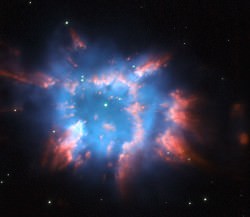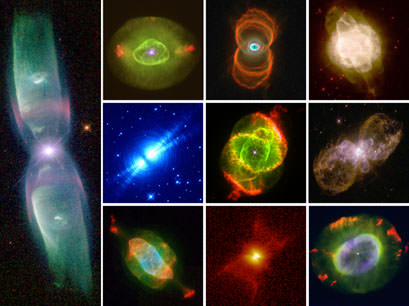[/caption]
Planetary nebulae come in a dazzling array of shapes, from spherical shells of gas, to blobby structures barely containing symmetry at all. Controversy has surrounded the cause for this diversity. Could it be magnetic fields, high rotation rates, unseen companions, or something else entirely? Recently, there has been a growing consensus that binary companions are the main culprit for the most irregular of these nebulae, but exploring the connection is only possible with a statistically significant sample of planetary nebulae with binary cores can be found, giving hints as to what properties they may, or may not, create.
Currently, astronomers recognize over 3,000 planetary nebulae within our own galaxy. Only ~40 are known to harbor binary stars at their core but astronomers are uncertain of just how many truly due. The difficulty lies in the amount of time it takes to search for a companion. Typically, companions can be discovered with spectroscopic measurements in the same way astronomers discover planets by detecting a wobble. Alternatively, binary companions can be teased out through eclipses but both methods require frequent monitoring and, until recently, were best suited for single target studies.
With the recent popularity of wide field survey missions, possibilities to detect more binary companions has increased greatly. These surveys are ideally suited for capturing eclipses or microlensing events. In each case, they will preferentially discover companions with tight orbits and short orbital periods which are suspected to have the greatest effect on the shape of the nebulae.
Stars that orbit close together are expected to have a strong effect because, as the primary star enters its post-main sequence lifetime, it is likely that the secondary star will become engulfed in the envelope of the primary, essentially sharing the outer layers. This creates large differences in density along the equator which leads to uneven ejection of the material as the primary star sheds its outer layers, forming the nebula. These temporary overdensities would serve to funnel material and could be responsible for the presence of polar outflows or jets.

A recent study has added two more planetary nebulae to the list of those with known binary centers: NGC 6326 (shown right) and NGC 6778. Collimated outflows and jets were discovered in both cases. The authors also note that both nebulae have filaments with low ionization. Such structures have been noted previously, but their cause has remained uncertain. A 2009 study suggested that they may be the result of tight binaries, a hypothesis that is strengthened by the the new discovery. The overall shape of NGC 6326 is mostly elliptical while NGC 6778 is bipolar.


So, those in the first pic are what? Regular, irregular?
The first picture is a mixture. Most look to have some pretty significant bipolar structure, but there’s also some elliptical shaped ones as well. Ones like the top right are hard to categorize at all.
I think there are: (the way they explode!)
5 bipolar (2 X, 2 lobes, 1 circles)
3 irregular
2 spherical
Additional:
1 elliptical
1 bipolar (no pic)